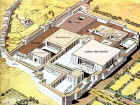| Index of articles from the Blog |
| Animals |
| Anthropology & Archaeology |
| Art & Cinema |
| Biography |
| Books & Authors |
| Culture |
| Economics |
| Environment |
| Fiction & Poetry |
| History |
| Humor |
| Justice |
| Philosophy |
| Photography |
| Politics |
| Religion |
| Science |
| Travel |
Books by
Books by
|
|
Herodotus saw many striking contrasts between the cultures of Athens and Persia.♣ Founded by Cyrus the Great in sixth century BCE as the Achaemenid empire, the Persian civilization lasted 1200 years, well past the Greek and Roman ones, until the coming of Islam. The empire at its peak, the largest the world had seen, extended from the Aegean sea in the west to the Indus valley in the east, from the Caucasus Mountains and Aral Sea in the north to the Persian Gulf and the Arabian Desert in the south. It was divided into tribute-paying regions administered by either appointed or hereditary satraps who underwent frequent inspections by officials reporting directly to the king. Royal inscriptions were trilingual—Old Persian, Elamite and Akkadian; Aramaic, however, was the language of imperial administration and diplomatic correspondence (also the language of Jesus Christ 500 years later). The Persians lived by the faith founded by Zoroaster in sixth century BCE - Zoroastrianism, and the dominant cult of Ahura-Mazda, the wise lord. Their sacred book was the Zend Avesta. According to traditional belief, 'the universe was a battleground, beneath the supreme God, between good and evil spirits; the good would win, but men and women of virtue and ritual purity could hasten the victory.'♣ |
|
Society was divided into three classes: chiefs and priests, warriors, and traders and farmers. There were particular gods associated with each class—the ahuras (lords), for example, which included Mitra and Varuna (also deities of the Aryan migrants to India), seem connected only with the first class. Zoroaster traced the origin of evil to an exercise of free will at the time of creation. The world was eventually to be consumed in a mighty conflagration from which only the followers of the good would rise to share in a new creation. Until then, the souls of the dead would cross the Bridge of the Requiter. The good would be led to wait in heaven, the wicked in hell. The end of each of its millennia is to be marked by the coming of a new savior, successor and posthumous son of Zoroaster. The last savior will bring about the final judgment, dispense the drink of immortality, and usher in the new world. Religious affairs were managed by the Magi—a priestly tribe credited with profound religious knowledge. A quasi-monotheistic faith, its resemblance to biblical lore is more than coincidental. |
 |
The empire sat lightly upon its subjects and its liberal tolerance let diverse peoples with different customs, languages, religions, laws, and economic systems to coexist peacefully—a conscious policy of Cyrus and Darius was to minimize disruption in the lives of the conquered peoples. Cyrus is known to have delivered the Jews from persecution in Babylon.♣ In the Hebrew bible, Cyrus is accorded a degree of respect given to no other non-Jewish ruler and to few Jewish rulers. Even in late sixth century BCE, law was a key aspect of administration. Stories of Persian justice abound in Greek sources. Darius particularly wished to be remembered as a great lawgiver, making legal reform a cornerstone of his public policy. In the provinces, two legal systems, possibly administered by two sets of courts, remained in force: a) local traditional law, b) imperial law based ultimately on the authority of the king. |
|
Persepolis, the springtime Persian capital, became the architectural centerpiece, where Darius' famed hall of audience inscribed this prayer for his people: 'God protect this country from foe, famine and falsehood.' The Royal road, the earliest and one of the many imperial highways, running 1500 miles across part of the empire was traversed by relays of mounted messengers in nine days. Besides promoting trade, building canals, and ports, the Achaemenids sponsored voyages of exploration to search for new markets and new resources. In scale and organization, the Persian empire was a precursor to the Roman one—mixing tastes, styles, and motifs together in an eclectic art and architecture that mirrored its peoples. Herodotus noted that 'There is no nation which so readily adopts foreign customs as the Persians.' Darius describes below the construction of his palace at Susa, one of the Persian capitals, later razed to the ground by Alexander who came by the Royal road, |
The Greeks: Previous |
Next: The Historian |
Designed in collaboration with Vitalect, Inc. All rights reserved. |
|











